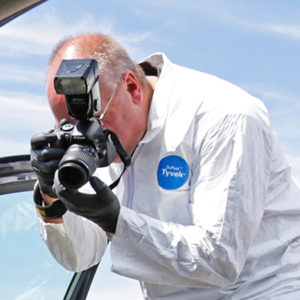
What types of photographs are taken at crime scenes?
Photography is the primary tool for crime scene documentation. Proper crime scene photography is a deliberate and systematic process. Its main purpose is to visually convey all aspects of the scene to someone who wasn’t there. To accomplish this, all crime scene photography consists of three basic types of photographs: overall, mid-range, and close-up.
Before describing these photographs, it should be noted that few crime scenes are single scenes. Separate rooms within a building, multiple vehicles at a crash site, and even individual bodies of the injured or deceased may all be considered mini scenes, and should be treated as such photographically. It is also important to understand that better documentation can be achieved when the photographer has more than one tool for the job. The addition of OSCR360 to a traditional DSLR camera workflow can maximize efficiency at a scene and improve viewer comprehension.
#1: Overall Photographs
Overall photographs, as the name implies, capture the overall aspects of the crime scene. Their purpose is to show exactly where the scene was, to the exclusion of any other location, and to show all boundaries of the scene. These photographs are typically taken in an overlapping fashion from the outside of the perimeter looking in, and from the center of the scene looking out, covering all areas of the scene. Items of evidence and their spatial relationships may be visible, but they are not the main subject of the photograph.
OSCR360 is ideally suited for overall scene photography: its ability to capture an entire room in one image saves time, eliminates the need to deliberately overlap photographs, and provides full transparency to opposing counsel and the court. Most importantly, an OSCR360 image depicts multiple spatial relationships in a way that just isn’t possible with a single traditional photograph.
You are not only capturing 360 degree photos, but you are capturing geo-spatial relationships and a sense of scale that are not found with traditional still photos. You can relate to where things are in the scene from the photos you take. You are able to ‘follow’ witnesses through a crime scene and you can bring the visual scene to juries as it was captured instead of verbally describing it.
Dick McEvoy, President, Forensic Imaging, Inc.
#2: Mid-range Photographs
Mid-range photographs transition the viewer from an “outsider looking in” perspective to a more involved perspective. Items of evidence and their spatial relationships are shown, typically by depicting a single item in relation to a fixed object in the scene. Done correctly, this technique will show proper context, perspective, and scale. It will also show the precise position of each item of evidence. The zoom capability of an OSCR360 image provides the foundation of a mid-range view and the context for further photographs. These photographs should be taken at a normal focal length in order to correctly depict distances. They can be embedded in a relevant spherical image captured by OSCR360 to visually cement their location within the scene. Learn more about police photography camera lenses here https://www.l-tron.com/police-photography-camera-lenses
#3: Close-Up Photographs
Close-up photographs are deliberate depictions of individual items of evidence. They must show all sides of the item and clearly show any markings, defects, or other identifying features. Each photograph is usually taken twice: once with a scale, and once without a scale. The image sensor of the camera must be oriented parallel to the surface being photographed, and the item must fill the frame of the camera. Shadows must be eliminated unless they are intentional (e.g., present from oblique lighting to show texture). Depth of field should be maximized so no details are left out of focus. Because of these requirements, close-up photography may be deferred until it can be accomplished under controlled conditions.
What types of photographs are taken at crime scenes – Wrap up
Capturing all three types of photographs at a scene is a critical part of crime scene investigation. Equally important is the ability to use those photographs to explain the investigation to a panel of jurors who were never there. The OSCR360 presentation software revolutionizes case management and the explanation process. Instead of an endless series of flat photographs accompanied by endless testimony describing the contents of each photograph, OSCR360 immerses the viewer in the scene. A testifying witness can zoom and rotate each image to provide context for his testimony rather than pausing as photograph after photograph is individually displayed. Embedded digital evidence can also be seamlessly displayed. For example, every latent print lifted at a scene can be individually documented from discovery to comparison, and that whole process can be stored in a single point of interest within a spherical photograph. OSCR360 has been used & accepted into court. The system has been critical in several high profile cases including connecting over 700 pieces of evidence in the Craig Rideout Murder Trial.
The need for proper crime scene documentation will never change – evidence-based prosecution is the cornerstone of our judicial system. Thinking beyond a DSLR camera and adding tools such as OSCR360 can strengthen investigations and provide total transparency during courtroom presentation. Visit www.l-tron.com/oscr360 today to learn more.
Interested in reading more articles like “What types of photographs are taken at crime scenes”? Here are some additional resources:
About the Author:

Andy McNeill
Andrew retired from the Monroe County (NY) Sheriff’s Office after spending the majority of his career in the Technical Services Unit, where he was responsible for crime scene investigation, collision reconstruction, and latent print examination. He was also the lead forensic instructor at the regional Public Safety Training Facility and a photography instructor at the New York State Academy of Fire Science. Andrew is an IAI-certified CSCSA and ACTAR-accredited Traffic Accident Reconstructionist. He has spoken on a variety of forensic-related topics at various colleges and conferences. In his spare time, Andy enjoys kickboxing, traveling and photography.